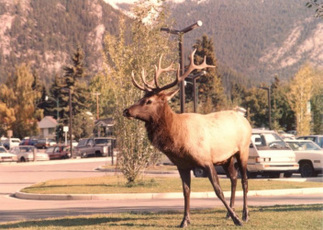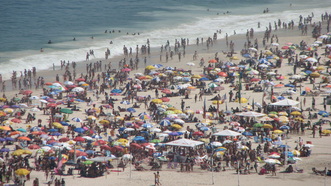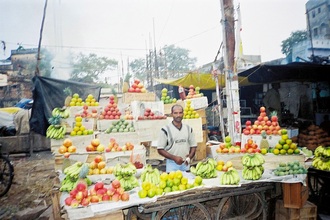Taking a break from the usual photo-stream, I've decided to participate in an initiative which the travel blog BootsnAll has created. Starting November 1, they launched a project called 30 Days of Indie Travel. They’re inviting bloggers from around the world (including you!) to join us in a daily blogging effort reflecting on our past travel experiences. Each day, they'll post a new prompt on BootsnAll articles. Bloggers can follow the prompts as strictly or loosely as they like, interpreting them in various ways and responding via text, photos or video posted on their own blogs.
Today's theme: Mistakes
Everyone makes mistakes. We forget to ask for Coke without ice in Mexico and spend the rest of the trip in the bathroom. Or we arrive at the airport for a 7pm flight only to realize the flight left at 7am. Tell us the story of your worst travel mistake.
Today's theme: Mistakes
Everyone makes mistakes. We forget to ask for Coke without ice in Mexico and spend the rest of the trip in the bathroom. Or we arrive at the airport for a 7pm flight only to realize the flight left at 7am. Tell us the story of your worst travel mistake.
Many time travelling you find yourself in situations where you may not know how to handle them due to either cultural differences, forgetfullness, or perhaps just that you've never been placed in a situation such as this before. The results of how you handle these situations dont always end up going as smoothly as one may have hoped. You could wind up sick, injured or even find yourself in a bit of trouble. This could be looked as as making a mistake, or as I prefer to see these situations: an opportunity to learn and to grow.
I'm sure I've found myself in countless of these situations, though thankfully have never found myself in 'too much' trouble as a result. Be it getting sick, mugged, or just plain lost, I've taken each of these situations with stride and only tried to further my understanding and awareness of the world around me. Let's take a look at some examples.
I'm sure I've found myself in countless of these situations, though thankfully have never found myself in 'too much' trouble as a result. Be it getting sick, mugged, or just plain lost, I've taken each of these situations with stride and only tried to further my understanding and awareness of the world around me. Let's take a look at some examples.

A male elk in Banff National Park
Wildlife
As per the name, wildlife is just that... wild. Many people travelling to an area which has an abundance of wildlife, some which may even find themselves in parks or other public areas, often forget that simple element. Familiarizing yourself with safe practices of how to treat the wildlife is extremely important. The animals may often be accustomed to having tourists tramping around them, they still have their own natural defence instincts in tact, and may burst out at an unsuspecting tourist trying to take pictures or get close to them. I had a very good learning experience, which actually put my life in jeopardy, while travelling to Banff National Park, in Alberta, Canada. The park is teeming with wild Elk, who migrate through the city due to the abundance of fresh cut grass to graze on in the parks there. Many visitors to the park assume the animals have been domesticated because of their presence there. Though in this situation, I did not approach the animals, nor do anything to aggravate them, other tourists had been taunting a particular pair, mother and baby, throughout the day. At one point I found myself laying in the park, face to face with the protective mother, who had already reached a breaking point from the earlier taunting. With the wrong movement of my own part, the elk turned on me, chasing me down and tackling me from behind. Luckily, this life threatening situation was quickly diffused by many locals who had been watching the situation unfold, and chasing it off once the attack had begun. I was quite fortunate, but should have been more apprehensive as the majestic animal approached. This situation could have been averted entirely had I been more aware of the threat that approached me. For a more detailed account of this story, check out my blog entry here.
As per the name, wildlife is just that... wild. Many people travelling to an area which has an abundance of wildlife, some which may even find themselves in parks or other public areas, often forget that simple element. Familiarizing yourself with safe practices of how to treat the wildlife is extremely important. The animals may often be accustomed to having tourists tramping around them, they still have their own natural defence instincts in tact, and may burst out at an unsuspecting tourist trying to take pictures or get close to them. I had a very good learning experience, which actually put my life in jeopardy, while travelling to Banff National Park, in Alberta, Canada. The park is teeming with wild Elk, who migrate through the city due to the abundance of fresh cut grass to graze on in the parks there. Many visitors to the park assume the animals have been domesticated because of their presence there. Though in this situation, I did not approach the animals, nor do anything to aggravate them, other tourists had been taunting a particular pair, mother and baby, throughout the day. At one point I found myself laying in the park, face to face with the protective mother, who had already reached a breaking point from the earlier taunting. With the wrong movement of my own part, the elk turned on me, chasing me down and tackling me from behind. Luckily, this life threatening situation was quickly diffused by many locals who had been watching the situation unfold, and chasing it off once the attack had begun. I was quite fortunate, but should have been more apprehensive as the majestic animal approached. This situation could have been averted entirely had I been more aware of the threat that approached me. For a more detailed account of this story, check out my blog entry here.

Crowded beaches of Rio de Janeiro during Carnival
Children
Seemingly the most innocent, our hearts often go out to seeing children who live on the streets in many countries around the world. This is not always the case, however. Often children who have been living on the streets for a while end up falling into street gangs, or working for larger crime rings, just as a means of survival. Be it on the crowded beaches of Rio de Janeiro, the busy streets of Berlin, or in the slums of India, this is something which happens all over the world. One of the most classic examples would be the children, sometimes referred to as "cardboard kids", who circulate popular landmarks throughout Europe, such as the Colosseum in Rome, who will send one child face to face with an unsuspecting tourist. With their hand outreached holding a piece of cardboard, they will confront the tourist pushing the cardboard against their chest, crying and yelling in their local language. While this distraction is happening, a group of other children will run behind the tourist, pickpocketing them for all their worth. By the time the confused tourist realizes that something isn't quite right, and that they're being mugged, the group of children will have disbanded in all different directions, making it impossible to chase them all down - at most only catching up to one of them.
Something similar started happening to me in Barcelona, Spain, while walking back from a bar late one night with a small group of travellers I had met at my hostel. A child, no more than 10 years old, approached and kept asking me to "Dance mister, dance with me". He would attempt to push himself up to me. Luckily, my old baggy pants had deep pockets with closed buttons at the top, and I very quickly realized what was happening, and shoed the child away. Relentless, however, he kept insisting, right up to the point that I felt their little hands trying to open my pockets. Pushing the child hard on to the ground, I heard a scream from behind me, as the desperate children took a more aggressive approach and jumped on one of the Australian girls I had been walking back with, attempting to snatch her purse away! We fended the children off showing our superior strength while huddling together. Thankfully the children did not come baring arms, but the lesson learned here was to walk in greater numbers late at night when passing through areas which may have this as a problem. Ask your hostel or hotel which areas are safe and which are known more for this type of threat, before venturing out at night.
Seemingly the most innocent, our hearts often go out to seeing children who live on the streets in many countries around the world. This is not always the case, however. Often children who have been living on the streets for a while end up falling into street gangs, or working for larger crime rings, just as a means of survival. Be it on the crowded beaches of Rio de Janeiro, the busy streets of Berlin, or in the slums of India, this is something which happens all over the world. One of the most classic examples would be the children, sometimes referred to as "cardboard kids", who circulate popular landmarks throughout Europe, such as the Colosseum in Rome, who will send one child face to face with an unsuspecting tourist. With their hand outreached holding a piece of cardboard, they will confront the tourist pushing the cardboard against their chest, crying and yelling in their local language. While this distraction is happening, a group of other children will run behind the tourist, pickpocketing them for all their worth. By the time the confused tourist realizes that something isn't quite right, and that they're being mugged, the group of children will have disbanded in all different directions, making it impossible to chase them all down - at most only catching up to one of them.
Something similar started happening to me in Barcelona, Spain, while walking back from a bar late one night with a small group of travellers I had met at my hostel. A child, no more than 10 years old, approached and kept asking me to "Dance mister, dance with me". He would attempt to push himself up to me. Luckily, my old baggy pants had deep pockets with closed buttons at the top, and I very quickly realized what was happening, and shoed the child away. Relentless, however, he kept insisting, right up to the point that I felt their little hands trying to open my pockets. Pushing the child hard on to the ground, I heard a scream from behind me, as the desperate children took a more aggressive approach and jumped on one of the Australian girls I had been walking back with, attempting to snatch her purse away! We fended the children off showing our superior strength while huddling together. Thankfully the children did not come baring arms, but the lesson learned here was to walk in greater numbers late at night when passing through areas which may have this as a problem. Ask your hostel or hotel which areas are safe and which are known more for this type of threat, before venturing out at night.

Fruit vendor in Varanasi, India
Sickness
It seems like something almost inherent with travelling, though it can often be avoided, or at least set to a minimum, if you practice preventative measures. I have spent several vacations where for a few days, the only sites I saw were my bedroom ceiling, and the porcelain throne. This is often caused by eating food which was poorly prepared, or grown in unsanitary conditions. Eating vegetables which grow on the ground in countries with very basic farming practices can bring with them many diseases and viruses which will make you sick. It's best to stick to eating fruit which grows up in trees, as there is much less of a risk of having the contaminants, such as diseased manure, coming in contact with the fruits. Eating a street stalls is also one of the best parts of travelling, but can bring with it the worst outcomes if not cooked properly. Make sure that you can see your vendor properly heating the food in front of you. If it comes out luke warm, it's probably going to make you sick. Another trick I've learned is to keep my nails cut quite short. This lessons the possibility of getting dirt and germs stuck under your nails, reducing the risk of those entering your body through contact with your mouth, or face. Insect repellant, of course, is also a key factor in keeping away the pesky, disease carrying mosquitoes which are prominent in most warm climates around the globe. Having had my share of sicknesses, these have become staple rules to follow when travelling abroad.
It seems like something almost inherent with travelling, though it can often be avoided, or at least set to a minimum, if you practice preventative measures. I have spent several vacations where for a few days, the only sites I saw were my bedroom ceiling, and the porcelain throne. This is often caused by eating food which was poorly prepared, or grown in unsanitary conditions. Eating vegetables which grow on the ground in countries with very basic farming practices can bring with them many diseases and viruses which will make you sick. It's best to stick to eating fruit which grows up in trees, as there is much less of a risk of having the contaminants, such as diseased manure, coming in contact with the fruits. Eating a street stalls is also one of the best parts of travelling, but can bring with it the worst outcomes if not cooked properly. Make sure that you can see your vendor properly heating the food in front of you. If it comes out luke warm, it's probably going to make you sick. Another trick I've learned is to keep my nails cut quite short. This lessons the possibility of getting dirt and germs stuck under your nails, reducing the risk of those entering your body through contact with your mouth, or face. Insect repellant, of course, is also a key factor in keeping away the pesky, disease carrying mosquitoes which are prominent in most warm climates around the globe. Having had my share of sicknesses, these have become staple rules to follow when travelling abroad.
These are just some of the lessons learned from making these simple 'mistakes' in my journeys, though for the most part, I was quite fortunate, and came out unscathed and with some good stories to tell, but one may not always be so lucky. Use common sense, and learn from these situations - and then post a blog about it so the rest of us can learn too ;)
 RSS Feed
RSS Feed

